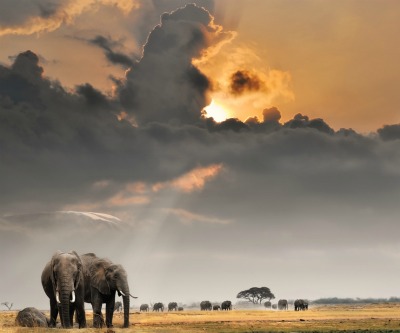
The race for natural resources in Africa includes copper, and South Africa, Zambia, and the Congo are particularly rich in the red metal. The continued rise in the price of copper, coupled with tighter supply worldwide, has intensified the desire of both large and small miners to increase their investment across Africa. At the same time, governments across the continent are demanding greater shares in profits from the country’s natural wealth, and the rights of mine workers are coming under closer scrutiny.
With interest in copper mines across Africa expected to continue increasing, legislators and corporate executives alike will be closely monitoring how local governments balance their economic needs with social and environmental concerns. Investors should be increasingly wary of changes in mining tax policies, as the possibility of labor unrest affecting output may increase.
Shift from South Africa to the Congo
South Africa is one of the continent’s biggest copper producers, with the Palabora mine producing about 75 percent of the country’s total red metal output. The financial future of the mine, however, is hazy as its two largest multinational shareholders announced last September that they plan to sell their respective stakes amid increasing political risks in the country. Rio Tinto (ASX:RIO) currently holds a 57.7 percent stake in Palabora Mining Company Ltd. (OTC Pink:PBOAF), while Anglo American (LSE:AAL) holds a 16.8 percent interest. Both companies stated that they are looking to invest in larger, longer-life assets, even as Palabora accounted for eight percent of Rio Tinto’s mined copper production in the first half of 2011. Mining giants in other commodities have also been retreating from South Africa in recent months as the ruling national party mulls the possibility of nationalizing mineral assets.
The Congo, meanwhile, is attracting more investors after years of civil unrest, including mining entrepreneur Robert Friedland. The Executive Chairman of privately-held Ivanplats, and CEO of Ivanhoe Mines (NYSE:IVN), said in early February that Ivanplats will be developing the Kamoa mine, Africa’s largest copper project in the country. Friedland commented that the mine will have a lifespan that can be “measured in generations as opposed to decades.”
China’s growing dominance
The Congo is also attracting the attention of Chinese investors, including Minmetals Resources (HKG:1208), which completed its $1.3 billion bid for Toronto’s Anvil Mining(TSX:AVM) in February. Anvil is heavily invested in the Congo, most notably in the Kinsevere copper mine in the Katanga province. Minmetals is a subsidiary of the Chinese state-owned Minmetals Group, and is the latest among publicly-owned Chinese companies to secure mining deals in Africa as the country looks to secure access to natural resources.
Last November, China’s Jinchuan Group successfully bid for copper and cobalt producer Metorex with the blessing of the governments of South Africa and Zambia, having beaten out Brazil’s Vale (NYSE:VALE).
China’s thirst for mineral resources is viewed by some industry analysts as an opportunity for junior miners to expand in order to meet growing international demand for copper mines.
Impact of resource nationalism
Heightened interest in Africa from mining companies has enticed governments to nationalize their mineral assets, or at least to impose hefty taxes on foreign investors. South Africa’s African National Congress is looking into the possibility of slapping a 50 percent mining tax on international producers, and a 50 percent capital gains tax on the sale of prospecting rights, which has led many multinational corporations to reassess their operations in the country.
Zambia has doubled its royalties on copper to six percent, while the government of Guinea has taken a 15 percent stake in all mining projects with an option to buy an additional 20 percent interest. As for Namibia, all new mining and exploration efforts have been transferred to a state-owned company.
Such moves by African governments have led resource nationalism to become one of the biggest international concerns for the world’s top 30 miners, according to a survey by Ernst & Young. The consultancy group said that the latest political shifts in South Africa have increased miners’ interests in Botswana, Mozambique, and Namibia instead.
Labor and environmental concerns
Labor unrest has continuously been a source of worry for mining groups regardless of location, and the surge in interest in African mines has increased awareness of how workers are treated. A Human Rights Watch report last November highlighted the abuse faced by Zambian copper miners at Chinese projects in particular. The New York-based advocacy group stated that “miners in Chinese-run companies have been subject to abusive health, safety, and labor conditions and longtime government indifference.”
Similarly, there is growing concern among citizens across the continent about the environmental impact of mining activities. At the Investing in African Mining Indaba conference held in Cape Town in February, Gold Fields (NYSE:GFI) Chairperson Mamphela Ramphela stated that “the mining industry was urged to take the lead in promoting sustainable development policies that add social and economic value.”
Securities Disclosure: I, Shihoko Goto, hold no direct investment interest in any company mentioned in this article.
Read at Resource Investing News
2 Comments
Anicetik
Anicet
Africa’s mineral wealth must reverse the economic plight of the Africans; African governments should be more responsible to the welfare of their people
Obi Wan Wotan
Looks like many places to work for all of the US African-American unemployed (+15%). Africa will need power plants, railroads, water/sewer infrastructure, etc. to develop all these mining interests -lots of jobs for African-Americans, one would think. And in the UK, unemployment of African males is almost 50%. 2012 = End of Time for immigrating to Over-Developed nations and staying where they hell they were born and fixing their own mess ?? One would think.